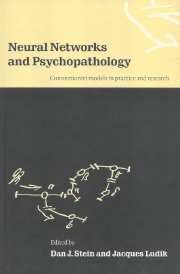Book contents
- Frontmatter
- Contents
- List of contributors
- Preface
- Part one General Concepts
- 1 Neural networks and psychopathology: an introduction
- 2 The history of neural network research in psychopathology
- 3 Neural network models in psychiatric diagnosis and symptom recognition
- 4 Neural networks and psychopharmacology
- 5 A connectionist view of psychotherapy
- 6 Modulatory mechanisms in mental disorders
- Part two Clinical disorders
- Epilogue
- Index
1 - Neural networks and psychopathology: an introduction
from Part one - General Concepts
Published online by Cambridge University Press: 12 January 2010
- Frontmatter
- Contents
- List of contributors
- Preface
- Part one General Concepts
- 1 Neural networks and psychopathology: an introduction
- 2 The history of neural network research in psychopathology
- 3 Neural network models in psychiatric diagnosis and symptom recognition
- 4 Neural networks and psychopharmacology
- 5 A connectionist view of psychotherapy
- 6 Modulatory mechanisms in mental disorders
- Part two Clinical disorders
- Epilogue
- Index
Summary
The recent shift in psychiatry from a predominantly psychodynamic model towards a neurobiological paradigm has led to important advances in our understanding and management of many mental disorders. At the same time, this shift has been characterized as a move from a brainless psychiatry to a mindless one (Lipowski, 1989). Certainly, the continued existence of different psychiatric schools with widely divergent approaches to psychopathology and its treatment suggests that psychiatry continues to lack an adequate theoretical underpinning.
During the same time that psychiatry has undergone a paradigm shift, academic psychology has also experienced a revolution – the so-called cognitive revolution against behaviorism (Gardner, 1985). Cognitive science, a multidisciplinary arena encompassing cognitive psychology, artificial intelligence, neuroscience, linguistics, anthropology, and philosophy, and based on computational models of the mind, is now a predominant approach. Not surprisingly, clinicians have asked whether the constructs and methods of cognitive science are also applicable to psychopathology.
Indeed, a promising dialogue between clinical and cognitive science has emerged (Stein and Young, 1992). Both cognitive-behavioral therapists and psychodynamic researchers have increasingly drawn on cognitivist work in their theoretical and empirical studies of psychopathology and psychotherapy. Schema theory, for example, has been applied to a range of clinical phenomena (Stein, 1992). Such cognitivist work is often immediately attractive to the clinician insofar as it incorporates a range of theoretical disciplines and insofar as it is based on hard empirical studies. One of the most important developments in modern cognitive science has been connectionism, the field concerned with neural network models (Rumelhart et al., 1986a).
- Type
- Chapter
- Information
- Neural Networks and PsychopathologyConnectionist Models in Practice and Research, pp. 3 - 13Publisher: Cambridge University PressPrint publication year: 1998
- 1
- Cited by



